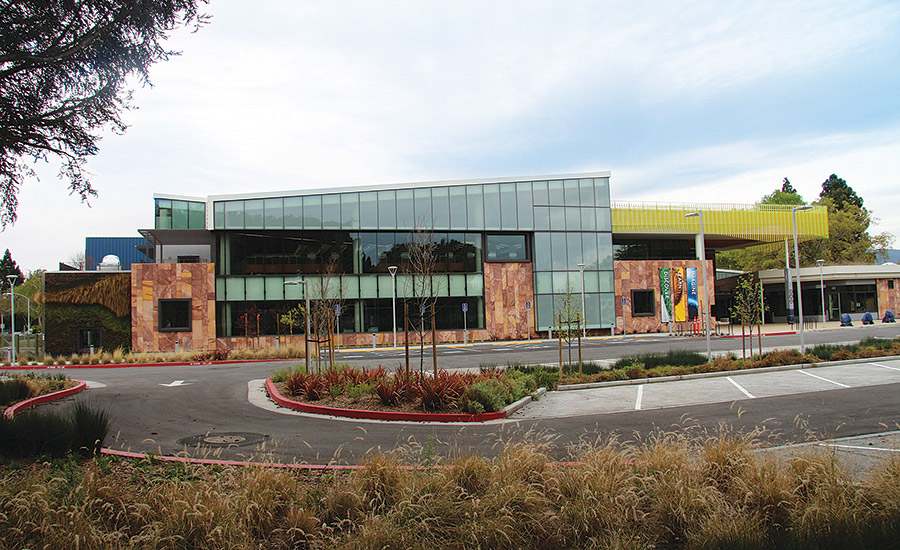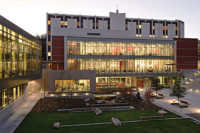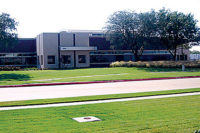The new $47 million Mitchell Park Library & Community Center recently opened with rave reviews for its IAQ and controllable air comfort. The 40,000-sq-ft, Palo Alto, CA-based library and its accompanying 16,000-sq-ft community center ranks first in air comfort among the city’s nearly 100 facilities, according to Debra Jacobs, P.E., LEED AP, PMP, project engineer for the Public Works Dept. of Palo Alto.
“This is by far the best air comfort of any city-owned building we have,” said Jacobs, who reports firsthand experiences since relocating her office into the facility during the final six month startup and commissioning.
The library is one of California’s most sustainable, as illustrated by the project’s LEED Platinum certification. The center also won last year’s Center of Excellence in the “Facility Design--Community Center/Mixed Use” category awarded by the California Parks and Recreation Society (CPRS).
Jacobs led a design team featuring Tunde Munz, P.E., LEED AP, principal at consulting engineering firm Guttmann & Blaevoet (G&B) in San Francisco; Jonathan Hartman, associate, Group 4 Architecture in South San Francisco, CA.; and Tony Guminsky, project manager at mechanical contractor Intech Mechanical in Roseville, CA. The design includes solar electric panels providing 25% of the library’s electricity, solar hot water panels, night sky radiant cooling with cold water storage, water reclamation, green living roofs, and raised floors with UFAD fabric ductwork for uniform air dispersion.
One of the two-story library’s most sustainable HVAC designs is the UFAD. It provides energy savings because the HVAC supply systems use less energy to maintain set point temperatures. UFAD also provides a more even temperature control in the 3- to 6-ft-high occupied zone versus other options, especially with Mitchell Park’s high ceilings, according to Munz.
UFAD offers advantages of positioning floor diffusers where the air is most needed. The raised floor also provides a space to conceal, add, or reroute electronic cables, piping, and other utilities for any future data equipment upgrades or room reconfigurations.
“Compared to UFAD, recessed or hung ceiling ductwork would be more difficult to maintain,” said Jacobs. “Cooling air from above the occupied zone is less efficient and the ductwork would also reduce the aesthetic floor-to-ceiling window views of the adjacent park and sports fields.”
UFAD has disadvantages, but G&B’s design solved them. Supply air temperature differentials of as much as 4°F are common in UFAD designs, especially in buildings with window-dominated walls, such as Mitchell Park. The thermal swings are due to low set point operating discharge temperatures required to meet the perimeter high solar loads, which in turn can create excessively cool interior area temperatures.
Slab and floor temperatures tend to increase the supply air temperature when it travels more than 50 ft, especially during early morning ramp-up periods, according to Munz.
Guttmann & Blaevoet is a UFAD proponent with the enhanced specification of UnderFloorSox, a textile air distribution system developed by fabric duct manufacturer DuctSox Corp., specifically for distributing airflow within the UFAD plenum. Engineers can design the system to get the air dispersed within areas prone to temperature rise. The flexible 18-in-diameter fabric duct uses laser-cut, linear vents that can be factory engineered and modeled to address any perimeter thermal decay and safeguard against overcooling interior zones. It can also easily be reconfigured and routed around the inherent myriad of cabling, piping, vertical floor supports, and other concealed UFAD obstacles.
In Mitchell Park’s design, Munz said G&B’s solution delivered the air strategically through the custom linear vents to facilitate a better distribution via textile duct with an adjustable air releasing end cap.
Reducing solar gain helps minimize UFAD perimeter thermal decay. Therefore, the design team specified highly-insulated Solarban 70XL glazing by PPG Industries. The glass has a U-factor of 0.439 and a shading coefficient of 0.359. The building also employs sun shades custom-designed and manufactured for each exposure. The walls and roof have a U-value of 0.05.
Supplying the UFAD system constructed of flooring panels by Tate are two 91-ton chillers by McQuay-Daikin, and two 1,250-MBh boilers by RBI that provide tempered water to air handlers by Haakon Industries and mixed into the plenum using the fabric. Supply airflow is dispersed into the occupied space through floor mounted adjustable diffusers or through floor mounted displacement diffusers (interior) or linear diffusers (perimeter). Fan-powered VAV reheat boxes by Price Industries draw airflow from the plenum and connect to the perimeter linear grills ensuring quick adjustment for additional perimeter load for cooling or heat.
The library’s IAQ monitor and control includes air handlers that supply economizer air when outside conditions are optimal. Additional house exhaust fans are used for cooling with mechanical ventilation. CO2 detectors also sense contaminants from large gatherings and activate natural ventilation.
The BMS by Automated Logic monitors and controls the indoor environments.
“This project has more than 350 points (measurement and control) compared to the 50 points at our City Hall, which is an older building with similar space volume and the same BMS network,” said Jacobs.
Besides IAQ, Jacobs attributes the air conditioning system’s low decibel operational sound to the UFAD, fabric duct distribution, and its linear dispersion, which all contribute to airflow noise suppression critical in library environments.
In previous buildings on the site, occupants walked through zones and experienced noticeable temperature differentials. The Mitchell Park Library & Community Center has very even temperatures throughout.
“As I walk through the building the temperature is amazingly consistent, even when comparing the west and east portions of the building in the late afternoon’s setting sun,” said Jacobs. ES







